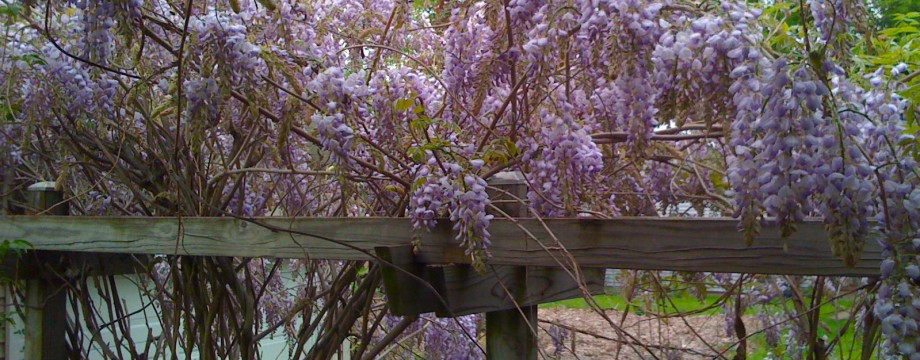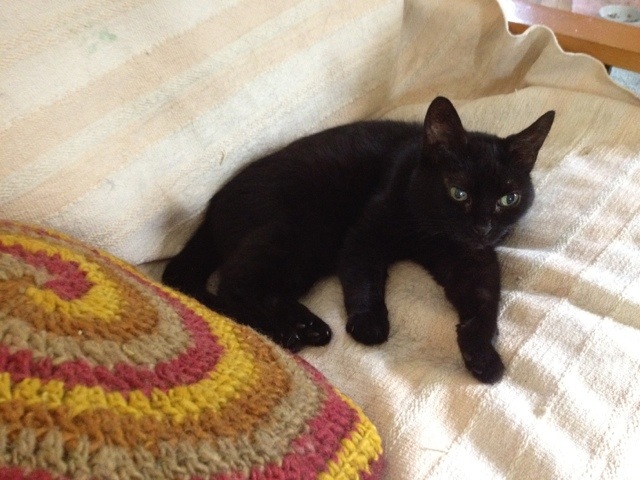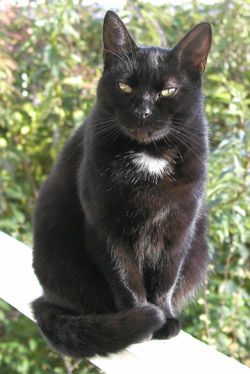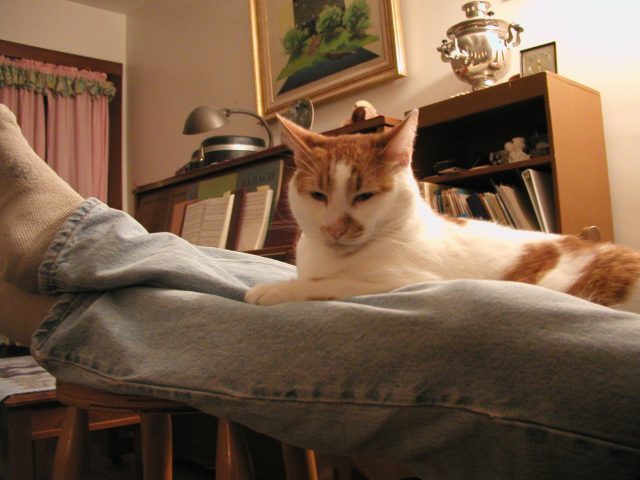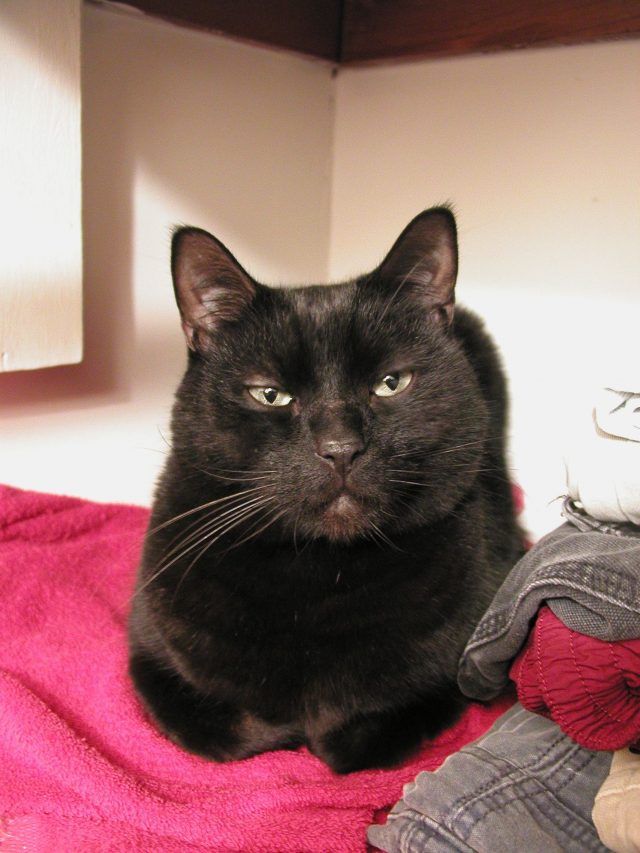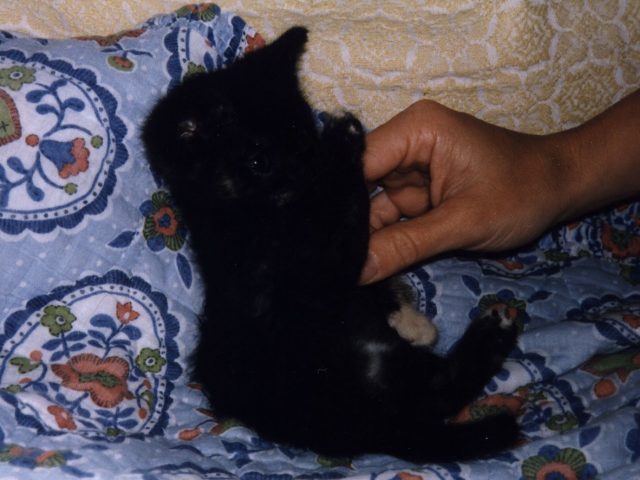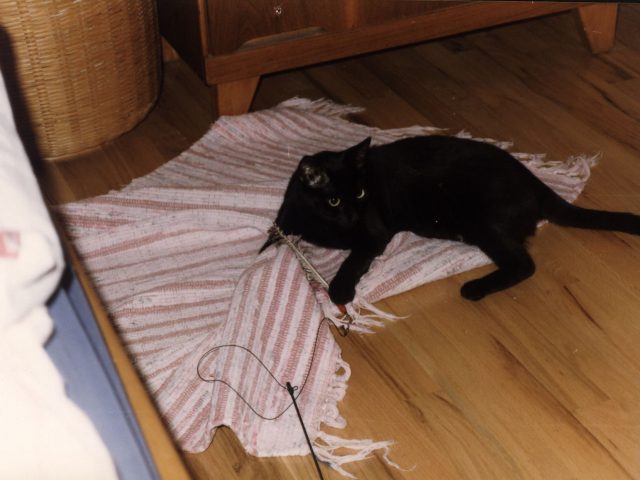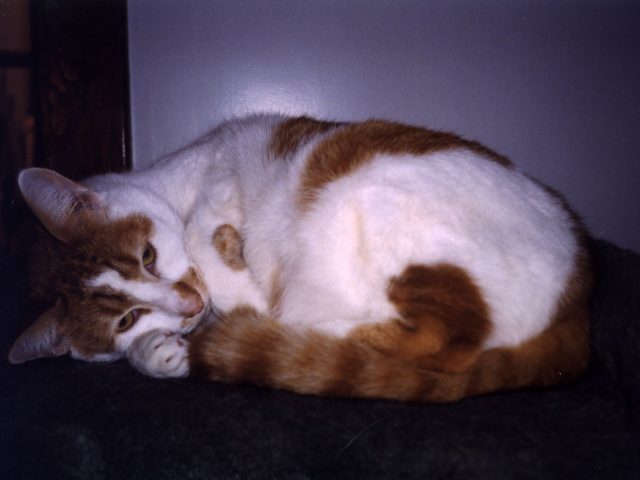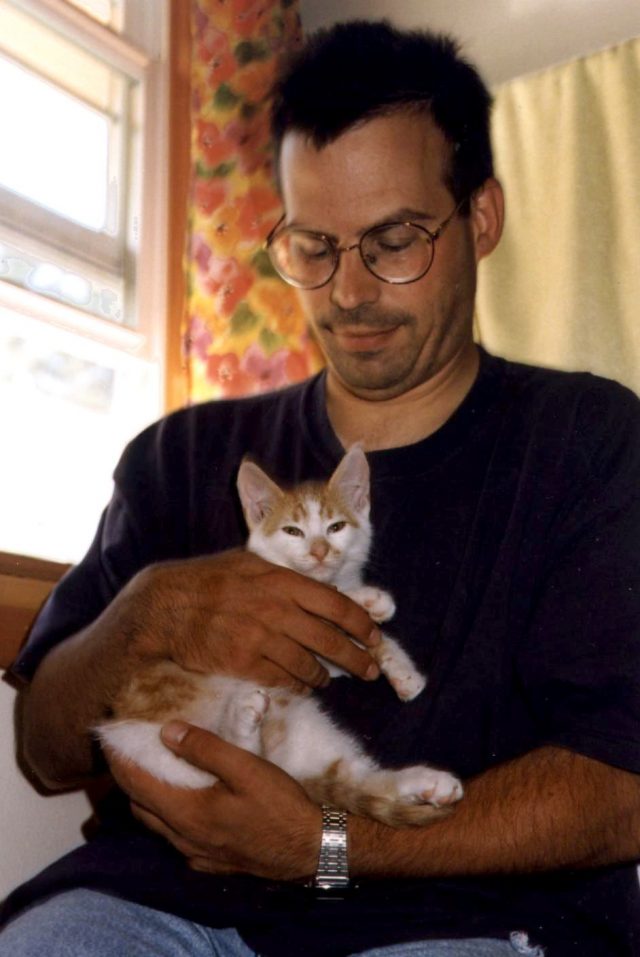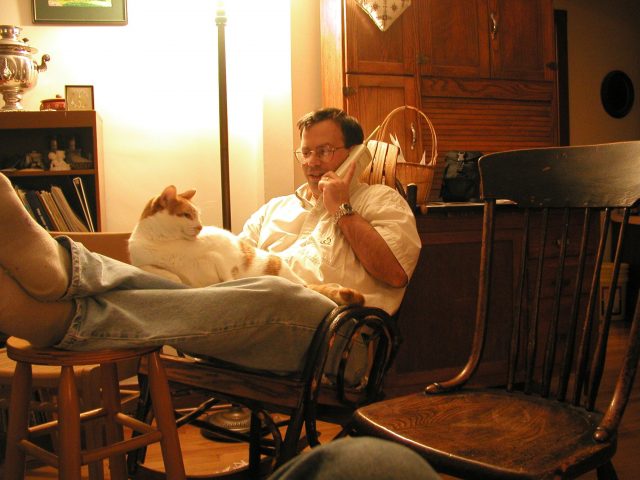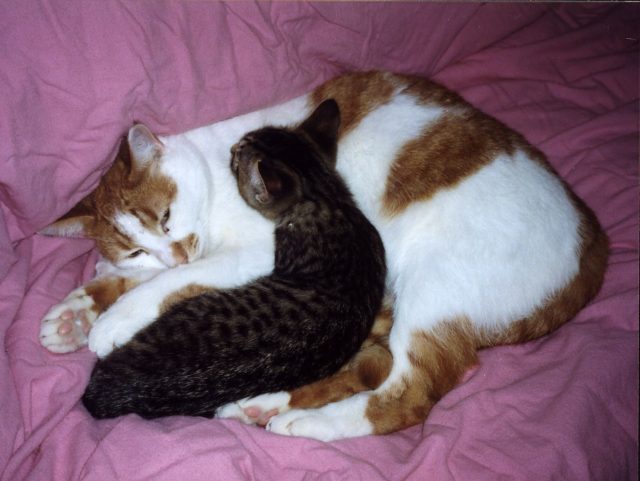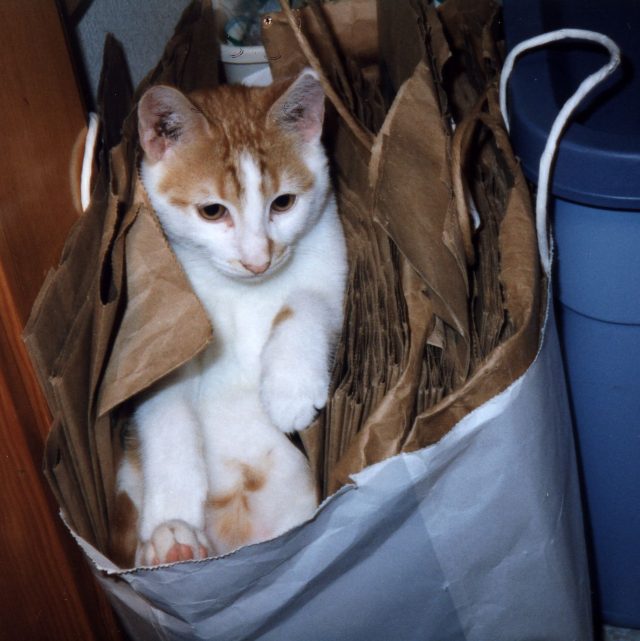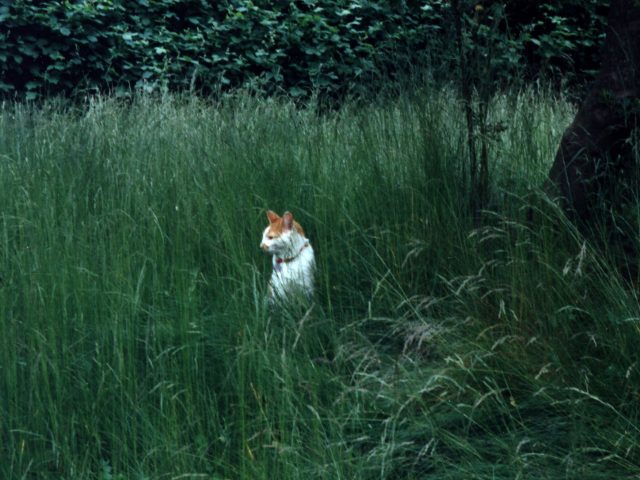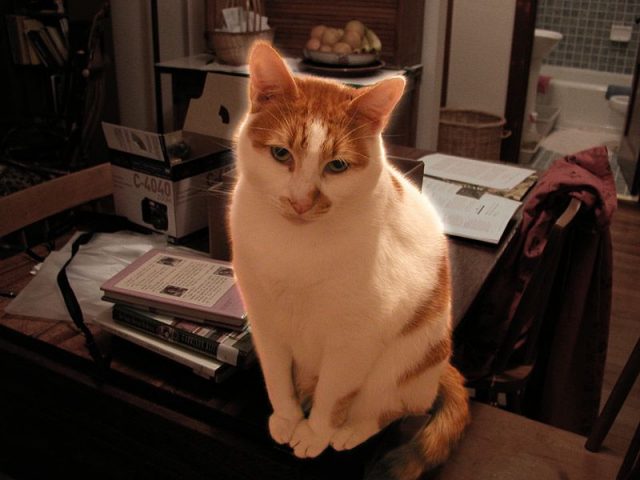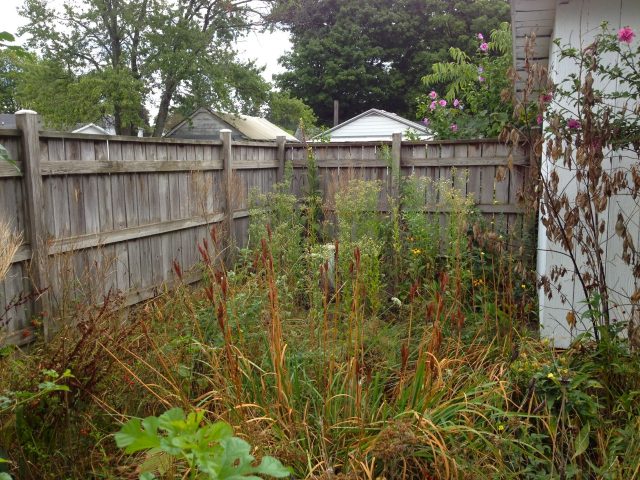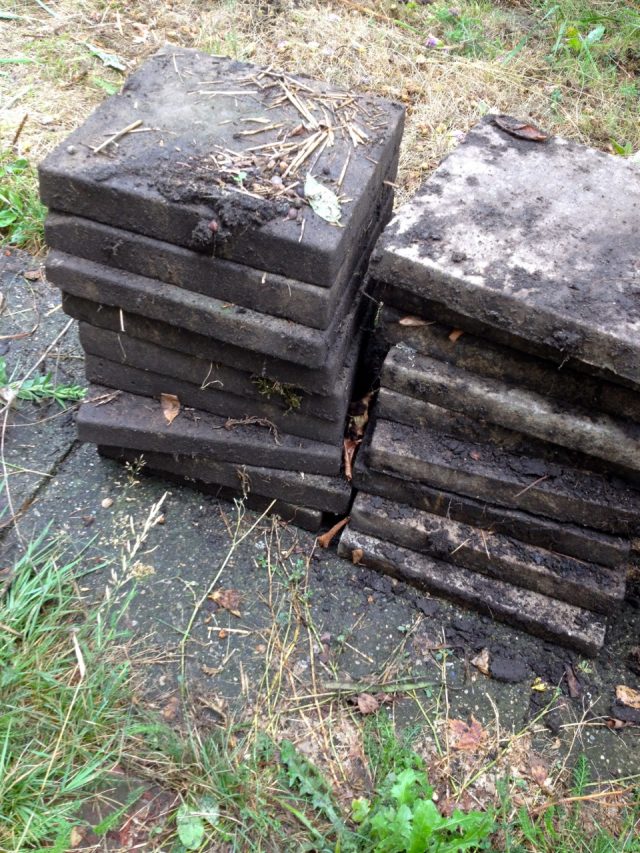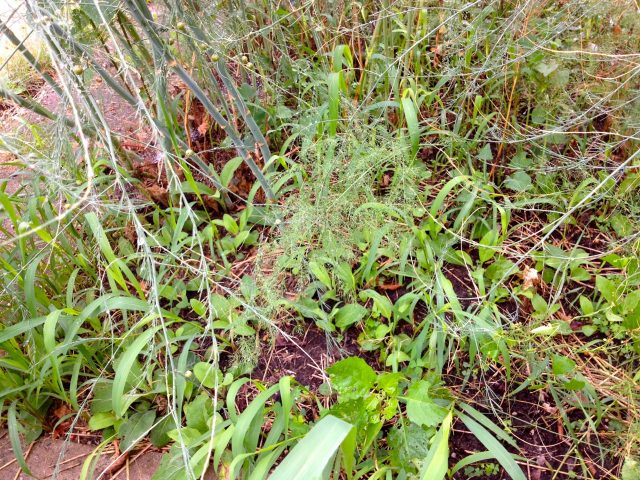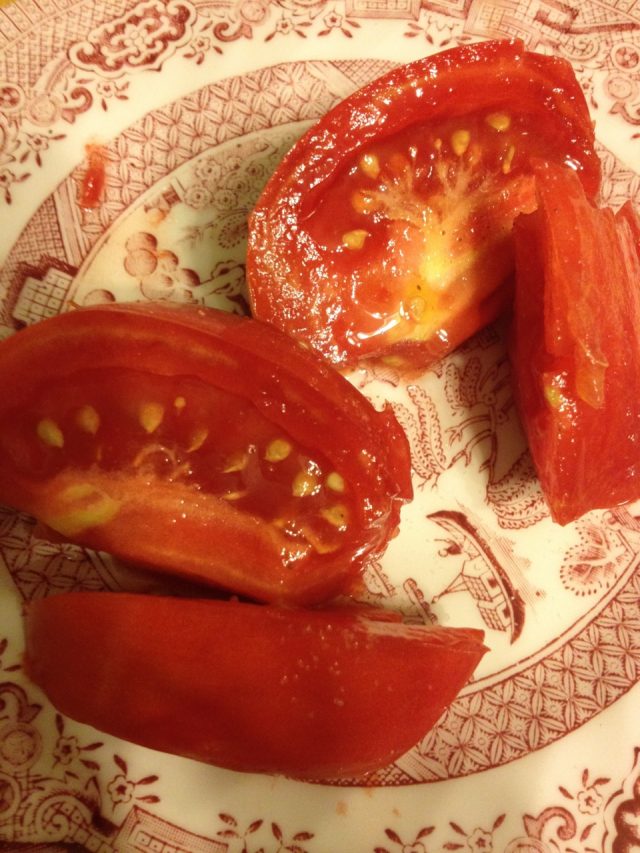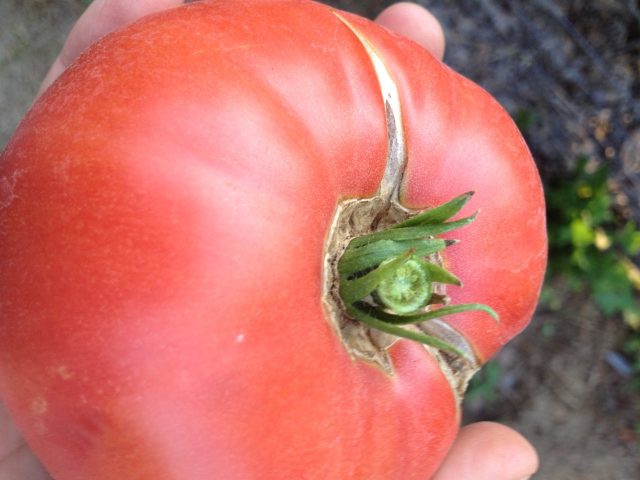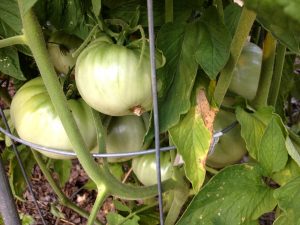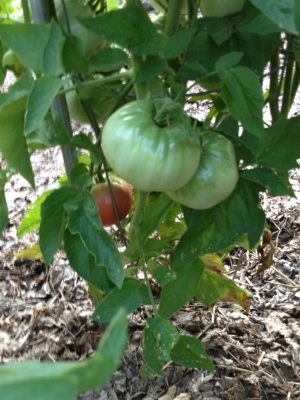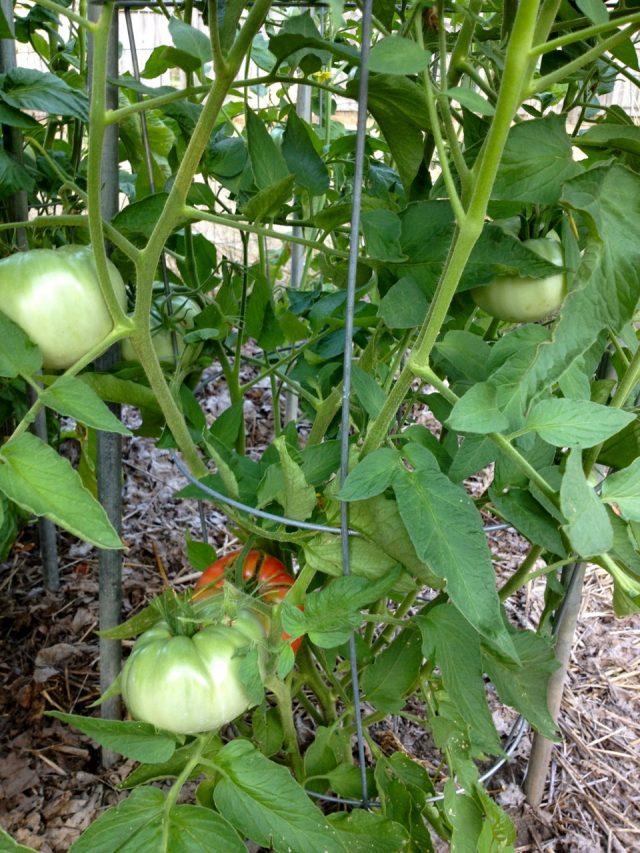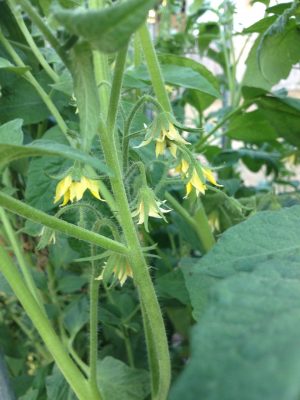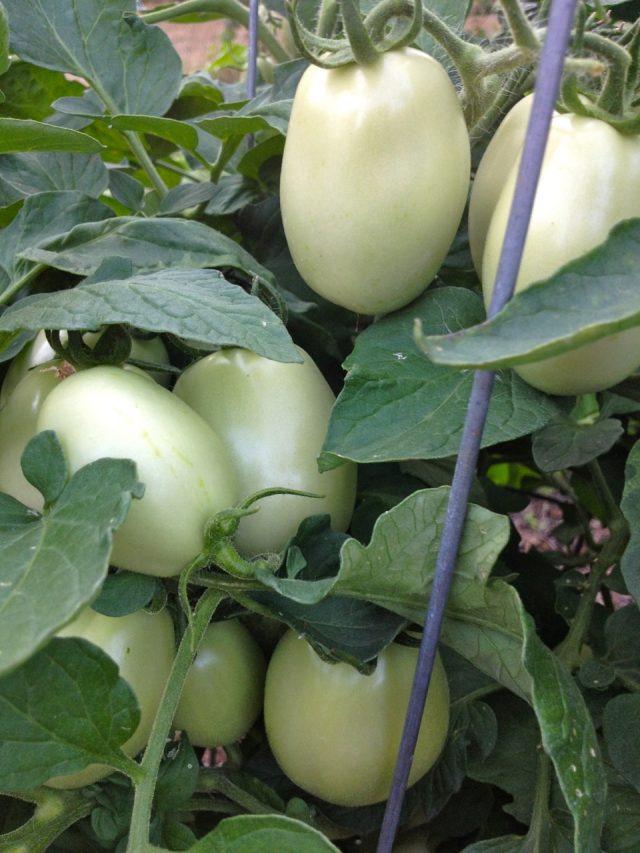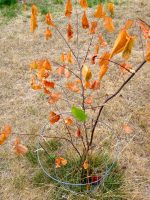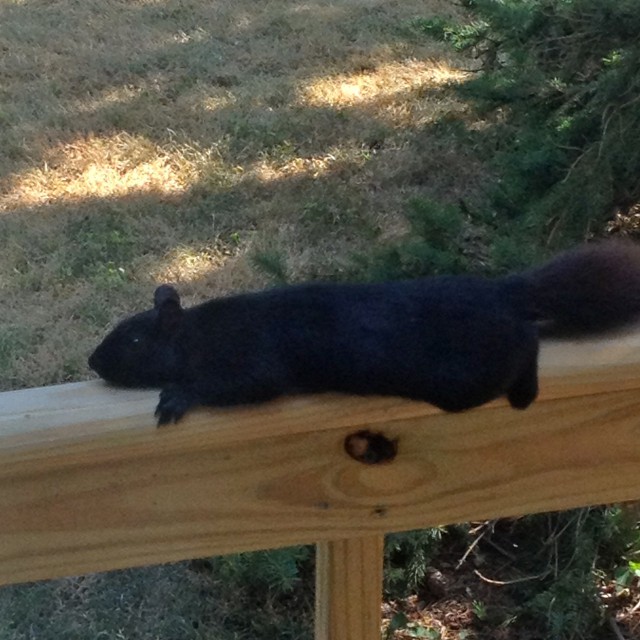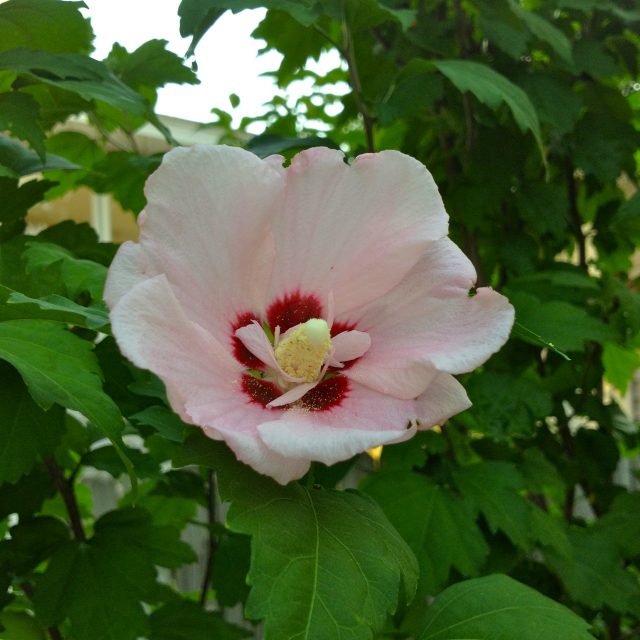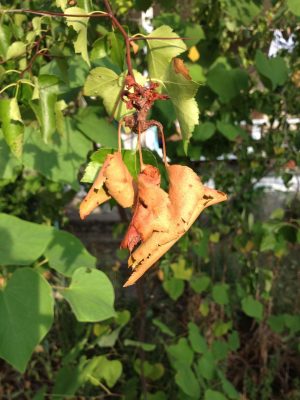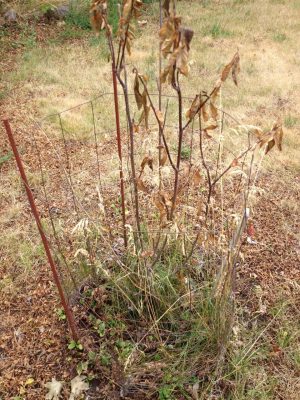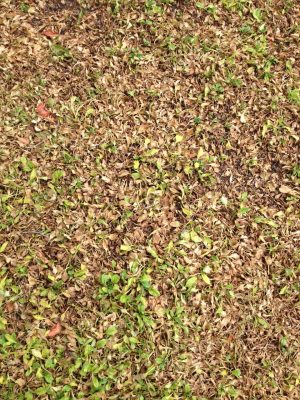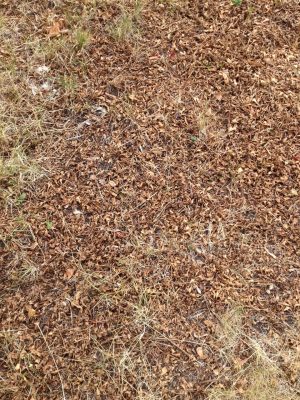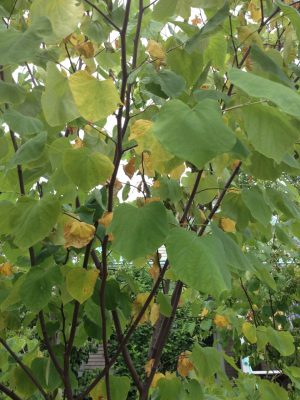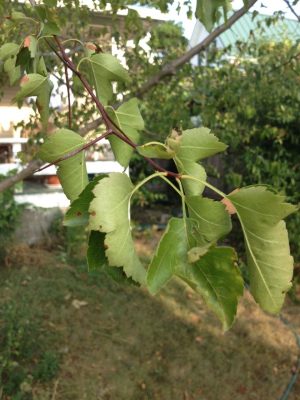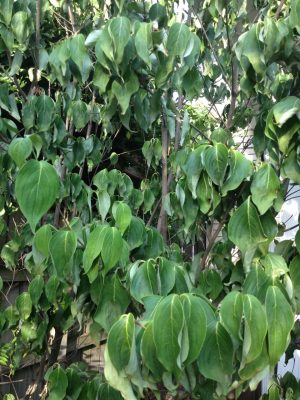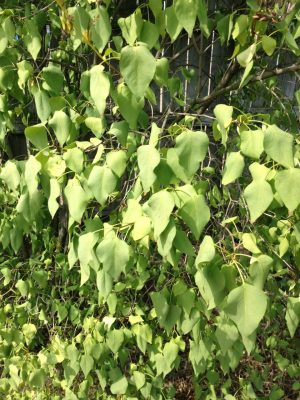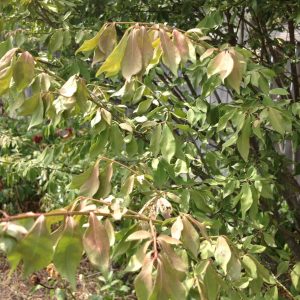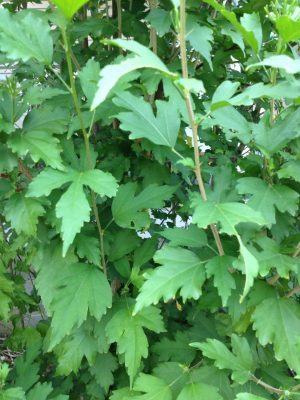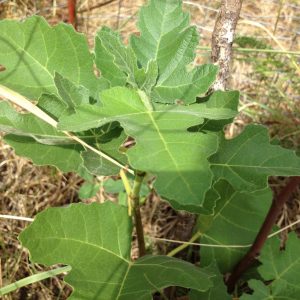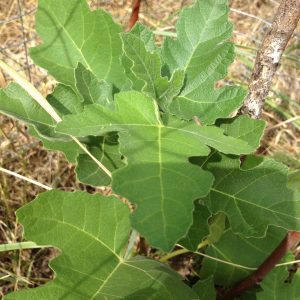D’Ni, not quite tame.
We can’t keep them safe
Today one of the deaf lady’s strays got hit by a vehicle right outside our driveway. I went over to her house to let her know and she followed me. When she saw the kitty, lying still on the road, she cried out, gently scooped it up, and carried it home.
How does she bear it? She must see this all the time. She cares for a lot of cats, so, while there are lots of births of new kittens, there must also be lots of deaths as well.
This woman feeds all the strays in the neighborhood. The strays run from everyone else, but they know her. They gather around her, snaking their way in and around her legs. They know when feeding time is and congregate outside her doors in expectation. There are cats that look hearty and well, cats that look skinny and mangy, cats that have goopy eyes, there are the kittens who soon learn to run and hide. I no longer see the blind cat, but he lived a remarkably long time outside in spite of being blind. The deaf woman loves all these cats, that is plain to see.
We also cared for an outside feral cat for a few years. But I didn’t think I could take the stress and worry anymore I wanted to keep D’Ni safe. I didn’t want to find her lying on the street. So we gave her no choice and, in spite of her howls, inside she came.
But can we ever keep them safe? We can’t. Even indoor cats die. And it is hard to see that. We can eliminate some dangers, but we cannot eliminate death. Death is part of a great circle.
By Rev. Andrew Linzey in his book, Animal Rites: Liturgies of Animal Care
Pilgrim God
who journeys with us
through the joys and shadows
of this world
be with us
in our sorrow
and feel our pain;
help us to accept the mystery of death
without bitterness
but with hope.
Among the shadows
of this world,
amid the turmoil of life
and the fear of death
you stand alongside us,
always blessing, always giving
arms always outstretched.
For this we know:
every living thing is yours
and returns to you.
As we ponder this mystery
we give you thanks
for the life of (Name)
and we now commit him/her
into your loving hands.
Gentle God:
fragile is your world,
delicate are your creatures,
and costly is your love
which bears and redeems us all.
Amen
It’s a lonely road but …
Today I posted memories of Macallan, a member of our family for 16 years. Yes, he was a feline member of our family, but no less a member because of his species.
I’ve always loved animals. My mother tells me that I would run after dogs because I wanted to hug them. There are numerous photographs of a young me picking up a kitten on the street. But, before I had animals of my own, I had no idea the depth of feeling that a person can have for their companion animal.
And now, I’ve lived with, and gone through the death of, four cats. And it can be a lonely road. There are no established protocols for caring for someone whose pet is ill or dying. I did tell a few people about Macallan. I did post about his death on Facebook. But on Sunday, in the Mennonite church where I play the organ, during the part of the service in which we name our joys and concerns, I did not get up and say that I was grieving. I did not know how people would have received that; I suspected (maybe incorrectly) that most would have thought that inappropriate for a church service. This same church has a service of remembering in November, right around All Saints Day, a service to remember those in our families who have died. Names are read, candles are lit. For the past two years, I remembered also, silently and crying inside: for Camille, for Duncan. This year, Macallan’s name will be added to my private list of rememberings. But I don’t dare ask for their names to be spoken out loud. I don’t dare ask for a candle to be lit. Religion can be so very human-centric. There may be prayers in prayer books for creation, but even those quickly turn to praying for human beings. Once, during Lenten Wednesday prayers, in a moment of silence, we were invited to name our petitions. All that I heard spoken were prayers for human beings. What was on my mind, though, was the plight of the polar bears, whose habitat was melting away. My “bless the polar bears”, which I did dare speak aloud, seemed out of place. Why is it that we don’t pray more for the animals? How can we support those whose companion animals, true members of their families, are ailing and dying?
Progress is being made. When we were buying Duncan’s ashes last year, I did an internet search for some kind of liturgy for burying a pet. Not surprisingly, many of the resources that I found came from Episcopal churches. The Episcopal church that I know and love has long had a tradition of blessing the animals. In all the Episcopal churches that I’ve been a member of, one Sunday a year is devoted to the blessing of the animals. Sometimes the service is held outdoors, so that animals of all sorts, horses, goats, chickens, as well as the usual dogs, cats, and hamsters, could be easily brought and blessed. But other times, the service is indoors, in the sanctuary, and the animals are welcome to attend. At Church of the Holy Spirit, on Vashon Island, the priest dipped a sprig of Douglas Fir into water that had been blessed and sprinkled all the animals that came. So I smile when I remember that Camille was, in a small sense, “baptized”.
In 2009, the Episcopal Church general convention resolved to “embrace the opportunity for pastoral care for people who grieve the loss of a companion animal” and approved the development of liturgies for the loss of companion animals, and in this year’s general convention (2012), authorized liturgies and prayers for animals. In addition to prayers for the loss of a companion animal, there are also prayers for adopting an animal, for a sick animal, for euthanizing an animal (I wish I had known this one when we took Macallan in to the vet), for animals affected by warfare, for farm animals, and for the death of a wild animal.
It is my hope that other church denominations would also expand their pastoral ministries to include parishioners and the animals that they care for.
This journey we are on, in which we give our love unconditionally to our companion animals has abundant joys and blessings. When we see those animals grow old, fall sick, and die, it is often a grief we bear alone. But I have hope that we will all come to understand that we need to care for one another in these instances as well.
References:
King of Peace Episcopal Church- Liturgy for the Burial of a Pet
Tribute to Macallan
“If you want a lap cat and a purr machine, then get an orange male cat.”
That was what a vet friend said to us when we were considering getting a second cat to keep Camille company. Later that summer, Macallan was found, a little kitten in the middle of a road, rescued and put into the foster home of that very same vet friend. He hung out with the feral litter that had been found earlier, and in August 1996, we brought him and his foster brother, Duncan, into our home.
Such a tiny thing he was then. And, sure enough, he was a purr machine. Duncan’s purrs were barely audible, but Macallan’s purrs could be heard by everyone. And he always wanted to be up on laps. But he was always so polite. He never just jumped up on someone’s lap. He would position himself and just look up at you, and, with his eyes, ask “Can I come up?” During the last few months of his life, he would never let me sit at my desk without asking to come up and lie on my lap. Not only did he like to lay on laps, he also wanted to touch fur to skin. In bed, he would seek out an arm lying outside the covers, and snuggle up so that fur was touching bare skin. When I was working at my desk, or reading, he would sit on my lap and drape his front paws over an arm. Another favorite spot was on Pete’s outstretched legs.
Macallan was also a very mild mannered cat. Even if he got angry at another cat, he would lift his paw rather halfheartedly and give a mild swipe that never did any harm. He quickly befriended both kittens, Whidbey and Gretel. But Whidbey became his very best snuggle friend. They were quite inseparable.
As a kitten, Macallan didn’t play a lot. And, of course, cat toys seldom interest the cats they were designed for. Instead ordinary household objects can become playthings. A bag of bags could become a fine cat bed.
Bags are such interesting things. A open paper bag, lying on the floor, could hide all sorts of things. So, of course, a cat must investigate. One day, Macallan decided to investigate the bag we had left open in the kitchen, unaware that, in sticking his head in the bag, he had also stuck his head in through one of the handles. When he found nothing of interest in the bag, he tried to back his head out. But it was stuck in the handle. Panicked he skidded across the slippery vinyl kitchen floor, crashing into the wall at the other end, while we, laughing, tried to rescue him.
Ceiling fans held a particular horror for him. He would get very worried whenever we would turn on. We wondered if he had been terrorized by a bird of prey while he was lost in the middle of the road.
In spite of being rescued from the wild outdoors, Macallan still would go outside, though not so much when we moved to Goshen. Illness made him brave again and he was always asking to go outside these past few months, up until the day before he died. He never wandered far, but he enjoyed the grass.
We will miss you little boy. May your gentle spirit always glow.
Working in the rain
It rained three times so far this week. This morning a gentle rain was falling; a rain that reminded me of days in Seattle; a rain that would not stop any true northwesterner from being outside; a rain that never stopped me from working in the yard and garden.
So outside I went. I’m expecting bees and a hive and I need to get the location prepared.
There was a pathway to clear;
there were pavers to dig up from another part of the garden to make into a pad for the beepod;
there were weeds in the asparagus bed that distracted me.
For two hours I worked outside.
Now..
Go directly to laundry. Do not pass through the house.
Am I the only one who manages to get this dirty after only two hours outdoors?
Tomatoes!
It may be hot and it may be dry, but the tomatoes are loving it. Yes – I have been watering the garden – not a lot – but every two to three days I either run the sprinkler a bit or go around with a bucket to water individual plants and rows. Temperatures have been high but the tomatoes have been loving it.
Tomatoes? You might remember my sad saga of my tomato starts. My starts did not make it, but the plants that I bought at the farmer’s market are doing just great. I bought seven heirloom plants, mostly Red and Yellow Brandywine, my favorite. And I bought 4 Roma plants, mainly for canning since I know that Romas are very prolific.
Today I had my first taste and it was very, very good. Fresh from the garden, still sun-kissed and warm, and full of flavor. (Sometimes I do think that minimal watering helps concentrate the flavor.)
These slices came from this tomato, nicely round, though it was splitting on one side (the side away from the camera – the split that may not look too appetizing).
That tomato came from these plants.
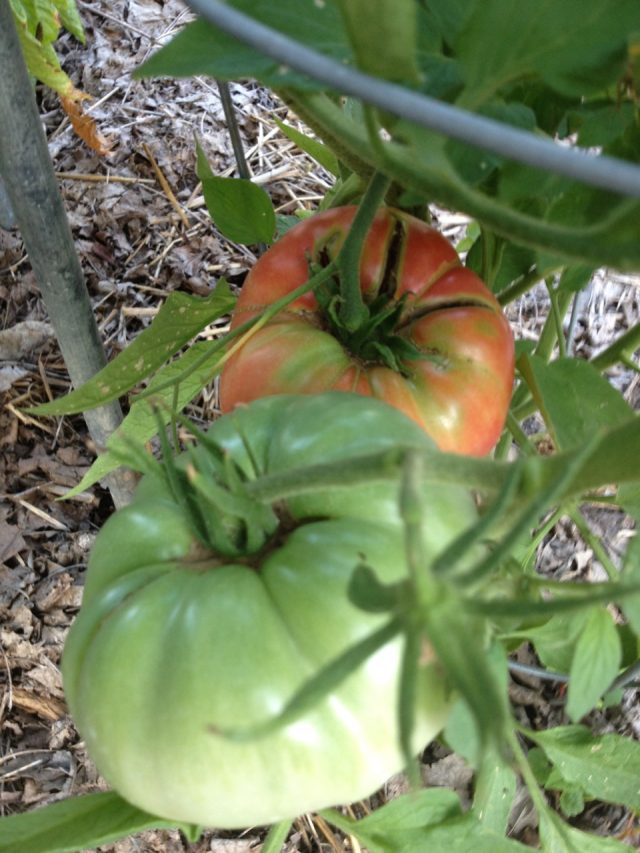
And more tomatoes are on their way!
Standard tomato cages, even large ones, are not really meant for large indeterminate heirloom tomato plants. Many of my plants are and trying to escape their cages (not that I blame them). And when the plants get heavy with tomatoes, the cages just can’t support them anymore. So I reinforce them with stakes. A few years ago I got some metal posts from my sister that work wonderfully. Even so, branches still manage to snake out and have to be tied. I think most people would use something made for gardening – twine for instance. But, in the spirit of recycling, my mum and I came up with a perfect alternative – newspaper bags! The Goshen News gets delivered to my mum’s house every day, usually in a bright orange plastic bag, just the right length to tie an unruly tomato branch to a pole.
These bright orange ties are also good for adding warning color to stakes that mark little baby trees that Arbor Day sends me to plant.
So my heirlooms are doing well. But the Romas are doing more than well. Each plant is bursting with tomatoes.
It’s a good thing there are so many tomatoes. I need to restock the panty. I think I’ll be very busy next month.
The Color and the Brown
Bushes are brown, but flowers still appear, giving color and hope in this dry summer. And it rained this morning (oh happy day!).
- Rose of Sharon
- Rose of Sharon
- Little weed flowers against the hostas
- Forsythia
- Baby Red Bud
Flowers in the Dry Summer of 2012
In spite of all the brown surrounding us this summer (brown grass, brown leaves on trees) there is still a bit of color.
Trees in the Dry Summer of 2012
I must admit that I have not been a good tree keeper this summer. It has been hot. It has been dry. And I don’t usually water. A lot of times, that does not matter because many plants are pretty resilient. But sometimes I should be more vigilant. We’ve lost trees to hot and dry summers before. Several years ago one of the mountain ashes just didn’t make it to the end of the summer.
And this year several trees are showing signs of stress.
A couple of weeks ago, we discovered that the Magnolia that we planted this spring looked quite dead. This is pretty sad and I wish we had paid more attention to it. It may already be too late, but we’re trying to keep it watered now.
Surrounding the magnolia is some weedy groundcover that a friend identified as dead nettle. I usually think that weeds (by this I mean any other type of plant in a lawn that most people, other than me of course, would consider unacceptable) survive harsh conditions better than grass. I’m not so sure any more. Where there once was this dead nettle is now really dead dead nettle.
So dead that there are now patches of dirt where there were once plants.
Other trees are also having difficulties.
The redbuds have many brown leaves.
The Washington Hawthorne’s leaves are curling.
The Dogwood leaves are almost completely folded in half.
Our Lilacs, Burning Bush, and Forsythia are having difficulty.
On the other hand, the Rose of Sharon is doing quite well.
And, surprisingly, the two little figs, which looked all but dead at the beginning of the spring, seem to have recovered and are thriving.
The cycle of life and death, played out in our backyard trees.
